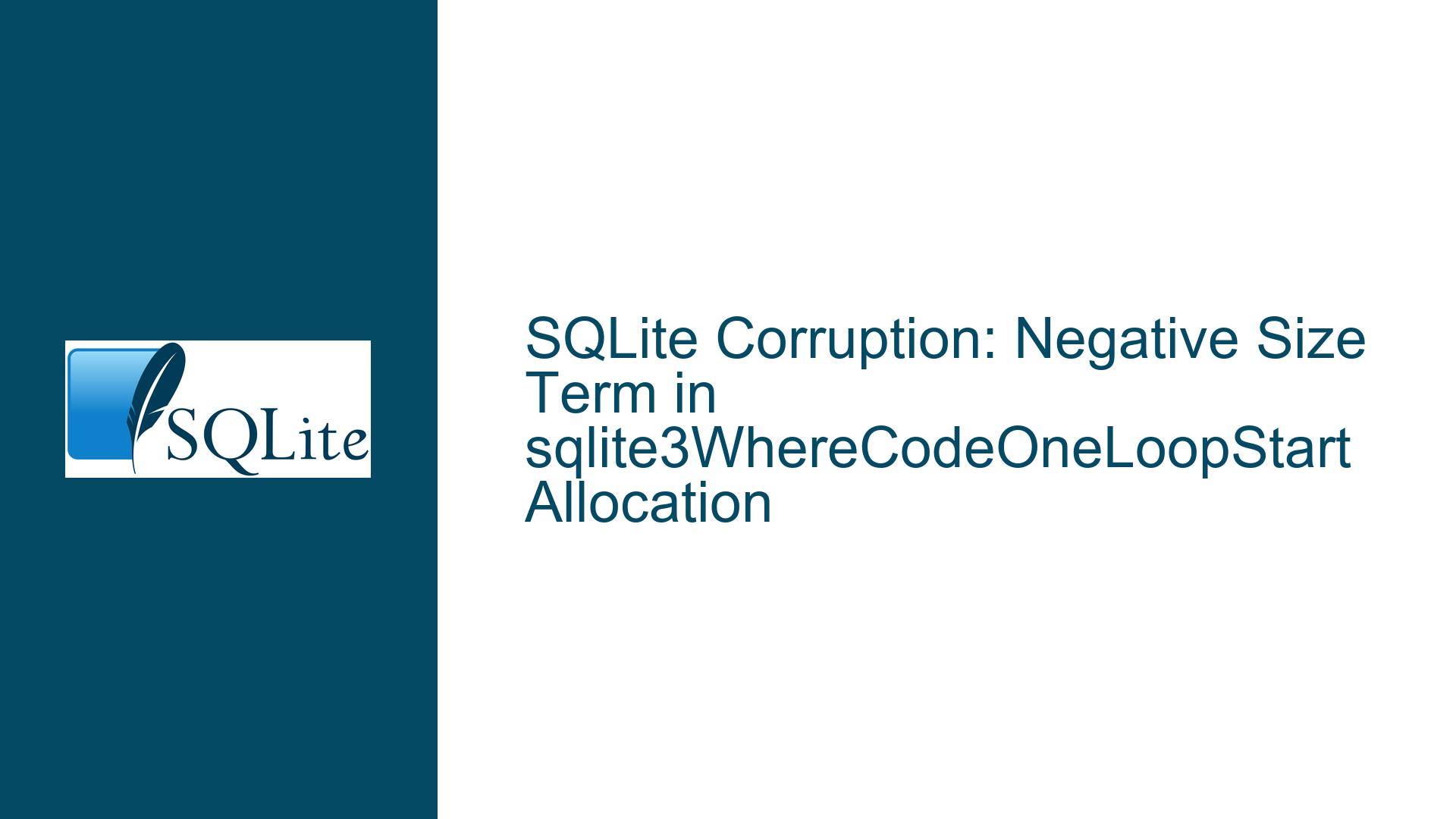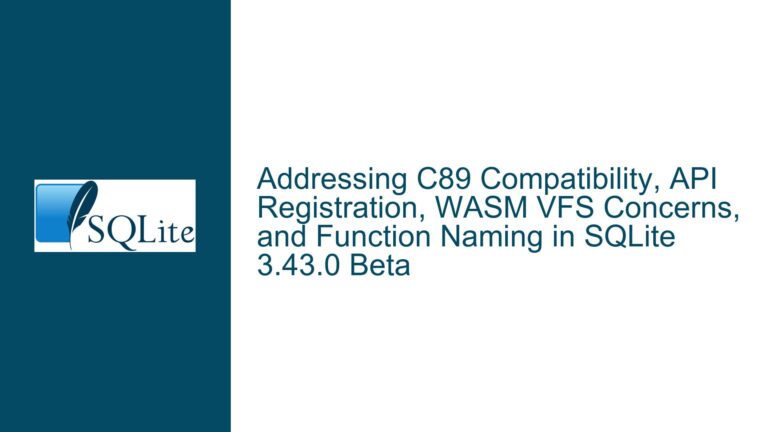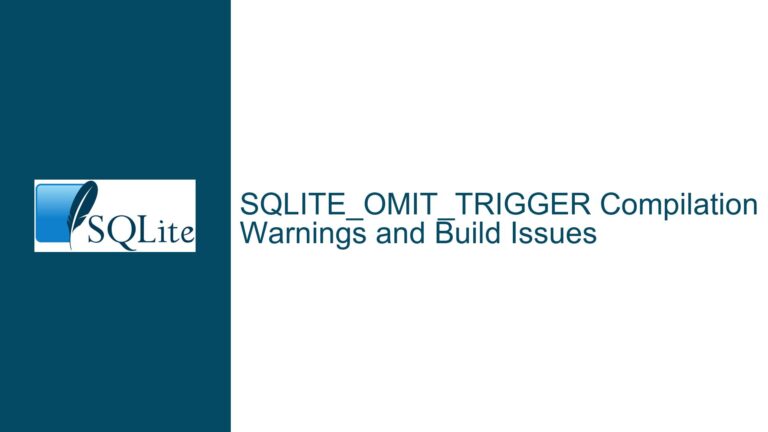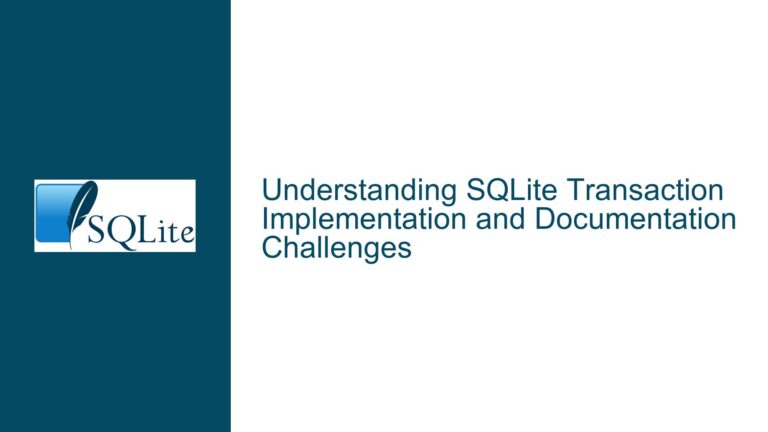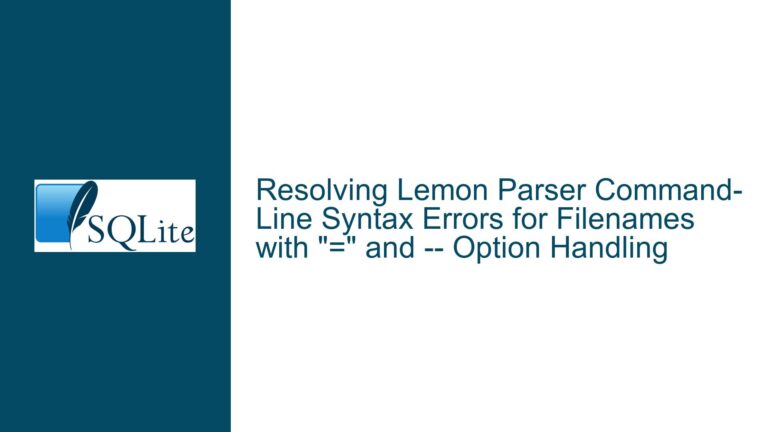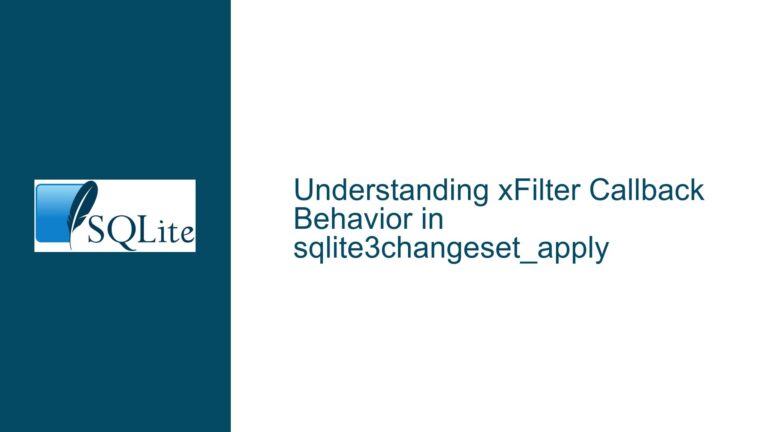SQLite Corruption: Negative Size Term in sqlite3WhereCodeOneLoopStart Allocation
Issue Overview: Negative Size Term and Undefined Behavior in sqlite3WhereCodeOneLoopStart
The core issue revolves around a memory corruption scenario in SQLite, specifically within the sqlite3WhereCodeOneLoopStart function. This corruption manifests as a null pointer dereference (pTerm = 0x0) and is traced back to an invalid memory allocation size calculation in the sqlite3WhereBegin function. The root cause appears to be an edge case where the nTabList parameter is zero, leading to an incorrect calculation of nByteWInfo, the size of the WhereInfo structure. This miscalculation results in a negative size term due to integer underflow, which subsequently causes undefined behavior when accessing the pWInfo->a array.
The WhereInfo structure is designed to hold information about the WHERE clause processing in SQLite. It includes a flexible array member, WhereLevel a[1], which is intended to dynamically allocate memory based on the number of tables involved in the query (nTabList). However, when nTabList is zero, the calculation nByteWInfo = ROUND8P(sizeof(WhereInfo) + (nTabList - 1) * sizeof(WhereLevel)) results in a large, invalid value due to the subtraction of 1 from nTabList. This leads to an incorrect memory allocation size, causing subsequent operations on pWInfo->a to access invalid memory regions.
The undefined behavior is further exacerbated by operations such as memset or memcpy on the pWInfo structure, which assume a valid memory layout. These operations can overwrite adjacent memory regions, leading to data corruption and unpredictable crashes. The stack trace provided indicates that the issue surfaces during query execution, specifically when processing a SELECT statement with a WHERE clause. The query in question involves a table named folder_properties and attempts to retrieve rows based on conditions involving folder_id and proptag.
Possible Causes: Edge Cases and Memory Allocation Miscalculations
The issue arises from a combination of edge cases and subtle flaws in the memory allocation logic within SQLite’s query processing engine. Below are the key factors contributing to the problem:
Zero
nTabListEdge Case: ThenTabListparameter represents the number of tables involved in the query. In certain scenarios, such as queries without a FROM clause,nTabListcan legitimately be zero. However, the memory allocation logic insqlite3WhereBegindoes not account for this edge case, leading to an incorrect calculation ofnByteWInfo.Integer Underflow in Size Calculation: The expression
(nTabList - 1) * sizeof(WhereLevel)results in a large, invalid value whennTabListis zero due to integer underflow. This causesnByteWInfoto be calculated incorrectly, leading to an insufficient or invalid memory allocation for theWhereInfostructure.Flexible Array Member Misuse: The
WhereInfostructure uses a flexible array member (WhereLevel a[1]) to dynamically allocate memory for theWhereLevelarray. However, the size calculation does not properly handle the case wherenTabListis zero, leading to undefined behavior when accessingpWInfo->a.Memory Overwrite Risks: Operations such as
memsetormemcpyon thepWInfostructure assume a valid memory layout. WhennByteWInfois incorrectly calculated, these operations can overwrite adjacent memory regions, leading to data corruption and crashes.Query Parsing and Execution Flow: The issue surfaces during the parsing and execution of a SELECT query with a WHERE clause. The query involves a table named
folder_propertiesand attempts to retrieve rows based on conditions involvingfolder_idandproptag. The specific query being executed is:SELECT proptag, propval FROM folder_properties WHERE folder_id=? AND proptag=?The presence of parameterized conditions (
folder_id=?andproptag=?) suggests that the query is prepared and executed multiple times with different parameter values, increasing the likelihood of encountering the edge case.
Troubleshooting Steps, Solutions & Fixes: Addressing the Negative Size Term and Memory Corruption
To resolve the issue, a combination of code fixes, testing strategies, and preventive measures is required. Below is a detailed guide to troubleshooting and fixing the problem:
Fix the Memory Allocation Logic:
- Modify the
sqlite3WhereBeginfunction to handle thenTabList = 0case explicitly. Instead of calculatingnByteWInfoasROUND8P(sizeof(WhereInfo) + (nTabList - 1) * sizeof(WhereLevel)), use a conditional statement to handle the zero case:if (nTabList == 0) { nByteWInfo = ROUND8P(sizeof(WhereInfo)); } else { nByteWInfo = ROUND8P(sizeof(WhereInfo) + (nTabList - 1) * sizeof(WhereLevel)); } - This ensures that the memory allocation size is calculated correctly, avoiding integer underflow and invalid memory access.
- Modify the
Validate
pWInfoBefore Use:- Add checks to ensure that
pWInfoand its members are valid before accessing them. For example:if (pWInfo == NULL || pWInfo->a == NULL) { sqlite3ErrorMsg(pParse, "Invalid WhereInfo structure"); return; } - This prevents null pointer dereferences and provides meaningful error messages for debugging.
- Add checks to ensure that
Review and Test Edge Cases:
- Identify and test other edge cases where
nTabListmight be zero or invalid. This includes queries without a FROM clause, queries with empty table lists, and queries with invalid table references. - Add unit tests to cover these edge cases and ensure that the fixes work as expected.
- Identify and test other edge cases where
Improve Memory Management Practices:
- Avoid using
memsetormemcpyon structures with flexible array members unless the memory layout is guaranteed to be valid. Instead, use safer alternatives such as initializing individual fields or using dedicated initialization functions. - Consider using memory analysis tools (e.g., Valgrind, AddressSanitizer) to detect and fix memory-related issues during development.
- Avoid using
Enhance Query Parsing and Execution:
- Review the query parsing and execution flow to ensure that
nTabListis correctly calculated and validated before being used in memory allocation. This includes checking for invalid or empty table lists during query preparation. - Add logging or debugging statements to track the value of
nTabListand other critical parameters during query execution.
- Review the query parsing and execution flow to ensure that
Backport Fixes and Test Thoroughly:
- If the issue is present in multiple versions of SQLite, backport the fixes to all affected versions and test thoroughly to ensure compatibility and stability.
- Perform regression testing to verify that the fixes do not introduce new issues or break existing functionality.
Document the Issue and Fixes:
- Document the issue, its root cause, and the implemented fixes in the SQLite source code and release notes. This helps other developers understand and avoid similar issues in the future.
- Provide guidelines for handling flexible array members and edge cases in memory allocation to prevent recurrence.
By following these steps, the issue of negative size terms and memory corruption in sqlite3WhereCodeOneLoopStart can be effectively addressed, ensuring the stability and reliability of SQLite in production environments.
